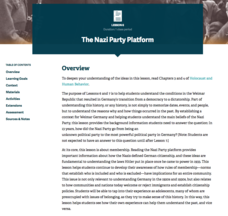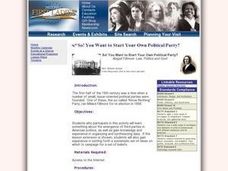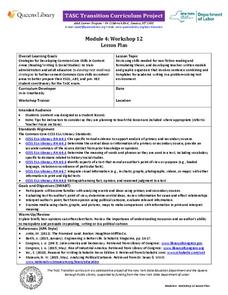Facing History and Ourselves
The Nazi Party Platform
Not all party platforms stay democratic. A resource covers many political issues in Germany during the time of World War II, and teaches pupils about the Nazi party platform and what went wrong. Individuals participate in a warm-up...
Theodore Roosevelt Association
Interpreting the Past; Assessing Its Impact on the Present
Even though the presidency of Theodore Roosevelt ended over 100 years ago, we can still learn something from his stances and policies that is applicable today. Class members first look over a list of prevalent political issues from the...
National First Ladies' Library
So! You Want to Start Your Own Political Party?
Students examine the emergence of third parties in American politics during the first half of the 19th century. Working in groups, they research a Third Party and determine why the party was founded as well as who were instrumental in...
Curated OER
Comparing Canadian and U.S. Political Systems and Political Campaigns
Students interpret historical evidence presented in primary and secondary resources. In this political systems instructional activity, students conduct research to compare and contrast the forms of government in the ...
Curated OER
Lesson Plan: Early Political Parties
Students examine the platforms of early political parties in the United States. For this political parties lesson, students discover details regarding the attributes and ideals of the federalists and the democratic-republicans. Students...
Curated OER
Artists Teach Us to See the World through Visual Symbols
Tenth graders analyze a biographical piece of art by Raymond Saunders. They identify shapes, symbols, and lines that are used, and how the piece relates to the artist's life and modern society. They design and create an original piece of...
Constitutional Rights Foundation
Winner-Take-All: The Two-Party System
Two's company, three's a crowd. High school historians learn about the Electoral College, a two-party, winner-take-all voting system in the United States. The lesson explains the pros and cons of the two-party system, roadblocks for...
Constitutional Rights Foundation
Why Don’t More People in the U.S. Vote?
To vote or not to vote, that is the question. Secondary scholars explore voter turnout in the United States. The resource uses informational text, group discussion, and a worksheet to help academics understand hindrances to voting...
Constitutional Rights Foundation
The Troubled Elections of 1796 and 1800
Congress does more than create new laws. Political scientists delve into the elections of 1796 and 1800 to understand how political parties, the Electoral College, and personal agendas affected the election process. The resource also...
Museum of the American Revolution
Image Analysis: In Their Own Words
Images often convey more than words. Scholars examine political cartoons from the American Revolution to understand how images have the ability to express political ideas. Academics participate in group discussion, complete a worksheet,...
National Woman's History Museum
Tea with Penelope: A 2-Point Perspective of the Edenton Tea Party
A brief introduction to Penelope Barker sets the stage for a discussion about political cartoons and the persuasive technique used to create them. A graphic organizer aids scholars in the analysis of a piece of work using a 2-point...
EngageNY
TASC Transition Curriculum: Workshop 12
How can opinions slant facts? Workshop participants learn how to examine primary and secondary sources and identify the author's point of view. They also examine how visual art impacts the meaning and rhetoric of sources. Full of...
Curated OER
Afghanistan: People, Places and Politics
Young scholars discuss their prior knowledge of Afghanistan. They work together to complete a study guide about Afghanistan's people and places. They present their information to the class.
Curated OER
Government: Texans in Politics and Civic Duties
Fourth graders examine the influence of Texans in national politics. They interview adults about the importance of participating in civic affairs. Students create brochures with three true statements and one falsehood. They trade copies...
National Endowment for the Humanities
The 1828 Campaign of Andrew Jackson and the Growth of Party Politics
High schoolers analyze changes in voter participation and regional power, and review archival campaign documents reflecting the dawn of politics as we know it during the critical years from 1824 to 1832. Students utilize worksheets and...
Curated OER
Willing to Participate: Political Engagement of Young Adults
Students consider what it means to be politically involved. In this civics lesson, students discuss voting as a privilege or right. Students also discuss how they may be able to effect social change through political involvement.
Curated OER
How Can Citizens Participate?
Middle schoolers are introduced to the notion of citizen participation. They analyze their own participation in the last school election, then read and discuss the definition of the term citizen.
Curated OER
Teacher Notes
Gathering information, distinguishing between arguments, preparing an oral presentation; these skills are fostered as 10th graders explore aspects of global trade and politics. They use the Internet to gather information about NATO, The...
iCivics
Municipal Government: High School
Municipal government takes on many roles, not just the ones we are used to hearing about such as Parks and Recreation. Scholars delve into the topic to get a grasp on how the government system functions. They participate in readings,...
Core Knowledge Foundation
A New Nation American Independence Tell It Again!™ Read-Aloud Anthology
Sixteen lessons make up a read-aloud anthology centered around America's journey toward independence. Scholars hear texts about the Boston Tea Party, Betsy Ross, the Found Fathers, the Liberty Bell, and more! Pupils discuss their...
Curated OER
A New Political Party
High schoolers participate in a Political Spectrum Analysis, then align themselves with other students with similar scores. In groups, they develop political parties, policies, philosophies, and organize political campaigns.
Curated OER
Donkeys and Elephants and Voters, Oh My!
Students celebrate party politics. In this American politics activity, students discover what the 2 main political parties in the country are and discuss their functions. Students then participate in a classroom simulation that requires...
Curated OER
Rebels Or Resisters?
Middle schoolers participate in a mock trial on the Whiskey Rebellion that took place in the state of Pennsylvania in 1794. They analyze the perspectives presented by both sides to determine whether the Whiskey "rebels" were guilty of...
Curated OER
Cartoons for the Classroom: Censorship, Silencing an Anti-War Voice
In this primary source analysis activity, students analyze political cartoons with anti-war messages and respond to 5 talking point questions.























